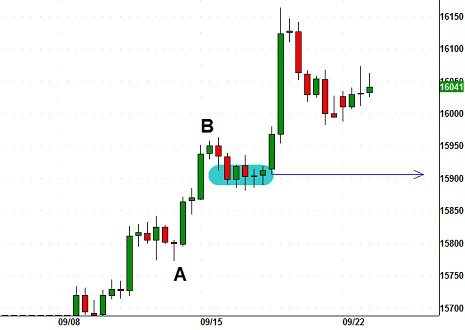 PLUS: Your first lesson in reverse-engineering the big player’s trades
PLUS: Your first lesson in reverse-engineering the big player’s trades
I had a bit of a panic on Sunday morning…
It was Kev’s 40th party on Saturday (he’s the eldest of our little gang; we’ve all kept in touch since 6th form)…
And as I came-to on Sunday, feeling a bit wooly-headed, this realisation hit me hard:
It’s MY 40th at the end of October!
Oh my goodness! Where has the last decade gone?
The thought of turning forty never really bothered me before, but it caught me a bit off guard in my delicate condition…
My missus thought it was hilarious of course. She kept laughing, giving me a dig in the ribs saying “what are you bothered about, it’s only a number”.
But come Sunday evening, I had to do something to cheer myself up. So I squirreled myself away in the lounge to watch a couple of movies.
Now I must admit… I’m quite a fan of gangster films, everyone likes a good mob film right? The Godfather and Goodfellas are my two favorites.
So I’m sat there, still sulking a bit, watching Goodfellas, and I start thinking…
“Hmmm, it’s a bit like trading this. The ‘Goodfella’ is your hands-on short-term guy. He’s active, close to the action, dishing it out and getting immediate results…”
Have you seen that film? Harry Hill – the main character – starts out as a bit of a street-hoodlum. He’s involved in the grimy day-to-day activities of the Mafia.
“…whereas a mature Don Corleone – the Godfather – runs things from a distance. He doesn’t get his hands dirty at close quarters. He pulls the strings and then waits for things to happen”.
So when you think about it in trading terms… which are you – Goodfella or Godfather?
Are you in for the quick hit or do you like pulling the strings on slow-burning trades?
Both ways can work of course. It’s all part of what makes a market.
Me? I’m more of a Goodfella – I like the consistency and reliability of day-to-day results. But then I’ve never really talked to you about my own specific way of trading before have I?
So today, I thought I’d give you a peek behind the curtain…
Now you may have heard me tell part of the story before: I first set off trying to find my own way through the trading jungle, just like you probably have.
I bought the books, followed the ‘gurus’, set about looking for the Holy Grail – you know, the system that never loses…
But it was only when I stepped back and took a good long look at what I was really trying to achieve that I took a leap forward by pestering two pro traders to mentor me.
They were ex-pit guys at the Chicago Board of Trade – a two-man team and part of the elite crew who’d successfully make the transition from pit to computer screen.
They still traded open-outcry on busy days though (they thrived off the buzz of a crowded pit) and they kept a little booth at the side of the pit so they could monitor the order flow coming in through the floor brokers.
Their style of trading was a kind of extended scalp. We weren’t going for just one or two ticks, we were holding out for four or five ticks in the Bonds… taking advantage of buying and selling pressure coming into the market from the big players – the institutions.
They taught me how to scope the market through the eyes of an institutional trader. Locating the price levels they’d be watching and then riding their shirt-tails as they ploughed into the market.
And it’s pretty simple stuff really – all about finding your spot, sticking your flag in the ground and waiting for the market to come to you and pick your orders off…
It’s a strategic, logical process – kind of like a game of chess
You’d be figuring out where the market’s likely to be in two-move’s time instead of waiting for indicator lines to cross or any of that stuff.
(And if you enjoy ‘getting under the bonnet’ and figuring out exactly how and why things work – you’ll probably love this style of trading too.)
But what mattered most was securing regular, consistent, daily profits.
There’d always be the odd off-day of course, that’s just reality. But it’s not about trying to break the bank with huge glory-trades…
Hone your skills just enough to take frequent, modest amounts from the markets and you’re all set. All you do then is scale-up your position size enough to meet your financial goals.
And the beauty of this approach is how it’s based on the unwritten laws of how all highly-liquid markets move. So whether it’s Bonds or currencies, the skill-set is easily transferrable.
So how do you step into the shoes of an institutional Forex trader and reverse-engineer their trades?
One simple technique is to look for areas where the market has found ‘fair value’ on a previous occasion, and then look for the market to make a re-test.
The market’s an inquisitive beast – it’ll try to flush-out trading intent wherever it suspects it to lie, forcing the players to reveal their hand.
So the theory here is if the market settled around a price area previously – there’ll likely be some participants who still view it as relevant on the second coming. Chances are they’ll become active again at that price level.
Here’s the kind of thing you can look out for:

(We’re looking at a 4 hour chart of GBPUSD in this example but you can use it on any of the major pairs.)
Consider the up-move from A – B. Can you see how a bit of selling pressure came in to eventually stall the move? It wasn’t enough to create a full blown reversal, but it was enough to knock the market down a peg.
We then went into a 5-bar holding pattern – the area highlighted blue. And this is what I mean by fair value. The buying and selling pressure was evenly matched over this period. The market didn’t really go anywhere.
This now becomes a price level to watch.
I’ve projected out a blue line to mark the level, the price is around 1.5906.
And if the market drops back off its recent highs, watch out for new buying pressure coming in at our level… a little area of support.
Expect renewed activity here – I’m not saying it’s going to be the reversal point that propels the market ever upwards, it might only be enough for a 10 or 20 pip scalp…
Or the bears might move things down through the level and we end up trading it as sellers – using it as a new level of overhead resistance.
But this is the kind of simple analysis that can give your trading plan a positive edge on the day.
By keeping aware of the points at which buying and selling is likely to come in, you can position yourself in front of that activity and let the market put wind in your sails.
And this example is just a start, a high-level overview.
There’s a lot more we’ll be looking at to get us closer to the current market. But have a think about what we’ve covered today. Does it make sense so far?
If you’re interested in doing this kind of analysis yourself, keep an eye out for my emails. I’ve had to move my coaching project back a little bit – it was originally due to kick-off on the 19th September – but I’ll have news for you very soon.
Be Prepared: Market Moving Data Coming This Week (London Time – BST)
Thursday’s Gross Domestic Product data for both the UK and the US are the week’s big data releases. Be wary of unexpected comments from any of the Fed’s speakers Thursday and Friday.
Wednesday 25th September:
13:30 US Core Durable Goods (USD)
15:00 US New Home Sales (USD)
Thursday 26th September:
09:30 UK GDP (GBP)
13:30 US GDP (USD)
15:00 US Pending Home Sales (USD)
15:10 US FOMC Stein Speaks (USD)
Friday 27th September:
10:00 EUR ECB Draghi Speaks
13:00 DE German CPI (EUR)
13:30 US FOMC Rosengren Speaks
19:00 US FOMC Dudley Speaks
I hope you enjoyed this issue and do let me know how you get on spotting your own ‘fair-value’ levels.

 PLUS: Your first lesson in reverse-engineering the big player’s trades
PLUS: Your first lesson in reverse-engineering the big player’s trades